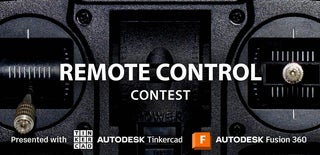Introduction: 3D Printed Autonomous Drone
Hello everyone..
It's more fun when you build your own flying drone rather than buying a expensive one also the best part is if it breaks you can 3D print it again.
The ability for complete customization is the fundamental benefit of 3D printed parts.
Printed parts can be in your choice of color and material. This way, you’ll be using the material with the best mechanical properties for the parts also the weight of your aircraft plays an important role, every gram on the aircraft has an impact on flight time and performance.
So Let's get started !!
Attachments
Supplies
For Drone assembly -
- 3D printer with filament
- Sand paper
- Tinkercad
- Velcro
- Nuts, bolts and washers for mounting the motors
For Drone Electronics -
- 4 brushless motors
- 4 ESC's - 30A ESC
- Receiver and Transmitter
- Lipo 3s battery 2200 mAh
- FPV system ( optional )
- Propellers
Step 1: Designing the Frame
- Tinkercad is a great tool, and I absolutely love using it If you have been wanting to design your own 3D printed object, Tinkercad is a great starting point.
- Whatever shape or size your drone takes, it needs to have a frame. Making a frame is the initial step, thus. You can use a variety of materials for this purpose, including wood, plastic, and metal. Depending on how durable you want the drone to be.
- Also you'll need to add the X frame so that it maintains the CG and weight distribution of your drone.
Step 2: Electronics
- Among the most crucial components of a working drone are the motors, ESCs (Electronic Speed Controllers), and propellers. To assure quality and dependability, So, you should get these components from an authorized store to ensure quality and reliability.
- Just make sure that when purchasing them they must match the size of your drone.
- Motors - The best motors for drones are multi - rotors motors as they generate greater speed and maintain a steady flying since each rotor coordinates with the thrust points.
- Propellers - I would recommend the Carbon fiber props as they are durable and won’t bend so easily if the drone hits something during flight.
- ESC 's - ( Electronic speed controller) are very crucial as they controls the motors rotation and speed.
- Lipo batteries' - The quality of batteries determines the flight timing so its very important to choose right brand batteries', I would recommend Onyx lipo as they are very efficient batteries.
- Receiver & Transmitter - There are so many good qualities of receiver and transmitters are available in market but I would suggest the one who has the most wide reception (range) as drones need large distances to cover.
Step 3: Printing the Parts
- Now this step require a lot of patience as printing will take time but the further results will be worth it.
- I have share the STL files of all the parts which you are required to print, the printing will take about a day and then you are good to go for the assembling.
Step 4: Assembling the Electronics
- The next step is to drill the motor mounting holes in the frame, taking into account the spacing between the motors' screw holes. Another hole that will allow the motor's clip and shaft to move freely.
- Once the motors are mounted attach the ESC's to the bottom side of the frame via zip ties to securely fasten the ESC to the frame. Your ESCs will be well-secured when flying.
- For attaching the lipo batteries use Velcro.
- Do the same with receiver and other connecting wires.
Step 5: Final Checking Before Maiden Flight
- Check all the controls before maiden flight.
- Check the weight of your drone.
You are all set for your first maiden flight you may add FPV and look for beautiful land view : D

Participated in the
Remote Control Contest

















